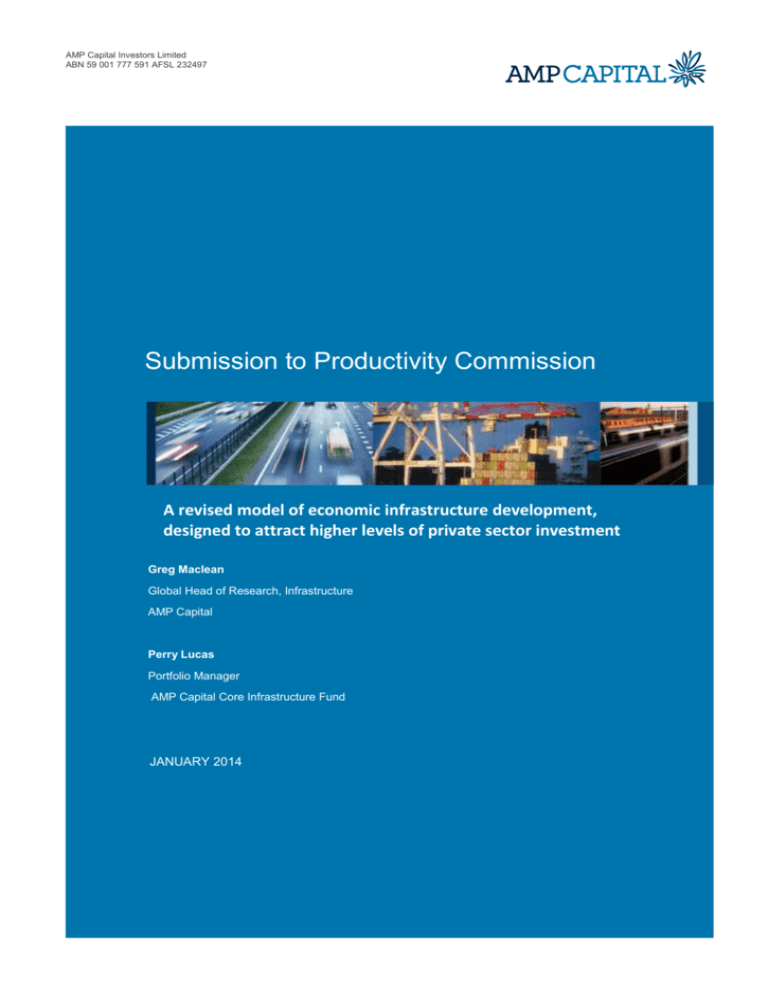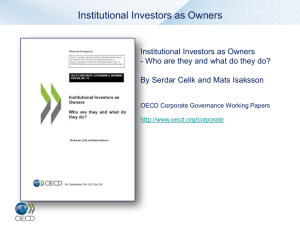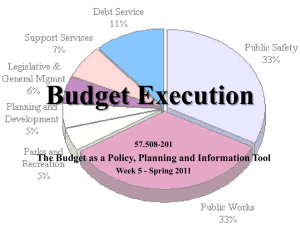AMP Capital - Productivity Commission
advertisement

AMP Capital Investors Limited ABN 59 001 777 591 AFSL 232497 Submission to Productivity Commission A revised model of economic infrastructure development, designed to attract higher levels of private sector investment Greg Maclean Global Head of Research, Infrastructure AMP Capital Perry Lucas Portfolio Manager AMP Capital Core Infrastructure Fund JANUARY 2014 AMP CAPITAL Contents Who we are ......................................................................................................................................................................... 2 Drivers of institutional investment in infrastructure .............................................................................................................. 2 A new model for private sector development of economic infrastructure ............................................................................ 5 Main insights ..................................................................................................................................................................... 10 // 1 AMP CAPITAL Who we are AMP Capital is one the largest investment managers in the Asia Pacific region with more than $135 billion under management (as at 30 September 2013). We are Australia’s longest established manager of infrastructure investments with more than $6 billion of assets under management in the asset class. Our clients range from small retail investors through to large institutions. This means that we have a deep understanding of infrastructure as an asset class from both asset management and investor perspectives. As a result, we feel that we are well positioned to respond to the Public Infrastructure Issues Paper. Fundamentally, policies designed to re-invigorate investment in economic infrastructure must both: > Increase the total level investment in infrastructure — In a period of constrained public funding, this means ways must be found to increase the attractiveness of new economic infrastructure to private sector investors; and > Increase the efficiency in the use of those funds – This includes maximising both the allocative efficiency of the use of those funds, i.e. by focusing on projects with higher leverage to economic growth, and delivery efficiency. Institutional investors and superannuation funds are amongst the best potential source of funds for increased total investment and have long been courted by governments to fund new infrastructure. However, greenfield economic infrastructure is not necessarily aligned with the requirements of many of these investors. However, we feel that it is possible to address this issue. Therefore, in this submission, we would like to share some thoughts on: > how to achieve better alignment between investment and investor requirements; and, > how this investor focus will require a revised model for the development of new economic infrastructure in Australia, if significant additional sources of private sector capital are to be mobilised. This paper includes a description and some worked conceptual examples of a potential model for the development of economic infrastructure, based on better targeting of Federal Government support. We believe that this could act as an effective catalyst for increased private sector investment. Assistance along the lines suggested should prove to be budget neutral, at worse, for the Federal Government. Drivers of institutional investment in infrastructure The first point that should be made is that capital is not constrained by international boundaries. Institutional and superannuation investors have a fiduciary obligation to provide the best risk-adjusted returns to their clients irrespective of geography. This means that an investment in Australian infrastructure must be attractive from both risk and return perspectives on a globally comparative basis, otherwise local and foreign capital will be deployed in other jurisdictions. Secondly, surveys have confirmed an increased interest from institutional investors generally in infrastructure investment1,2. According to these surveys, institutional investors are increasingly viewing infrastructure as an alternative to fixed income. Infrastructure is seen as a particularly good fit for pension funds and insurance companies, given their long duration liability profiles. 1 2 Trends in Large Pension Fund Investments in infrastructure: OECD,2012 The 2013 Preqin Global Infrastructure Report // 2 AMP CAPITAL For example, Figure 1 below shows the anticipated rise in allocations to infrastructure by major OECD institutions surveyed by Preqin3. If these intentions are eventually realised, this would represent a doubling of the current allocation from 5% to about 10% of total funds under management over the medium term. More recent surveys by AMP Capital confirm this trend4. An example is the recent announcement by AXA of an increase in its allocation to infrastructure debt from €1 billion to €10 billion over five years5. Figure 1: Current & target institutional allocations to infrastructure 60% Current allocation Target allocation % of Funds Interviewed 50% 40% 30% 20% 10% 0% <1% 1%<5% 5%<10% 10%<50% >50% % Allocation Source: Preqin, AMP Capital. The preferred investment route for the majority of institutions surveyed was indirectly through specialised infrastructure funds. The 2013 Preqin survey identified 137 unlisted funds seeking to raise approximately US$85 billion. As at the end of October 2013, US$ 29 billion had been raised, equal to the 2012 total 6 . This suggests a growing momentum and when an allowance is also made for direct institutional investments, large amounts of capital will be available for potential deployment into infrastructure in the short to medium term. While the increased interest in infrastructure by institutions is welcome, the 2013 Prequin survey suggested that the most attractive characteristic of the asset class was access to long-term secure cash flows which are often inflation hedged. The risk profile of an infrastructure asset varies over its lifecycle. This is illustrated in Figure 2 which shows the impact of the changing risk profile on asset valuations as the asset advances through development to maturity. In a mature operating asset, future patronage and operational risks can be determined with a high degree of reliability whilst earlier stage construction and ramp-up risks have been managed and mitigated. This allows a significant reduction in equity risk premium. 3 The 2012 Preqin Global Infrastructure Report 4 AMP Capital Institutional Investor Research Report, October 2013. AXA Press release, June 2013 5 6 Prequin // 3 AMP CAPITAL Figure 2: The infrastructure life cycle Source: AMP Capital In comparison, greenfield developments are inherently riskier. A developer of these assets will require a risk premium to cover development and operational risks, including patronage risk. This means that future cash flows are more uncertain than for mature assets. That is, the risk profile of greenfield developments is less aligned to institutional investor objectives than mature assets. In addition, greenfield projects often have long bidding, procurement and development timetables, while institutions may prefer projects that allow capital to be deployed in an immediately value accretive manner7. The focus of the Productivity Commission’s Issues Paper is to develop means to accelerate the development of greenfield economic infrastructure projects with high GDP to cost multipliers. The above discussion suggests that that institutional interest in such projects will be relatively limited compared with their interest in mature assets. New ‘social’ infrastructure investment through public-private partnerships (PPPs), also provides a better fit with institutional objectives than greenfield economic infrastructure. Typically, these projects can be structured so as to allow: > rapid procurement and development; > development and operational risks to be substantially passed through to third parties; and, > patronage risk to be generally borne by the government. This allows future cash flows to be delivered to the investor in a more timely and predictable manner, providing good alignment with investor objectives. From a government perspective, institutional investment in social infrastructure should displace public sector investment and, thereby, provide the option of deploying funding to other priority areas. This means that any revised model of public/private sector collaboration in developing new economic infrastructure should be additional to, and not cannibalise, the current levels of private sector investment in social infrastructure. The success of recent secondary market transactions in Australia, including privatisations, clearly demonstrates that institutional investors are particularly interested in mature assets. These transactions are characterised by quantifiable demand and future brownfield development risks. 7 An example of a recent secondary sale of economic infrastructure to institutions is the sale of Leighton’s telecommunications assets to Ontario Teachers for approx. $620m in June 2013. // 4 AMP CAPITAL This suggests that newly developed economic infrastructure could be equally attractive to institutional investors if the assets are first similarly ‘de-risked’. This would require the re-emergence of specialist developers of economic infrastructure who would fill much the same role as property developers in taking the initial development risks. These developers could sell the asset, once it reached maturity, through secondary markets to institutional investors. As long as the project meets its planned performance objectives, the developer would realise a development profit and have the option of recycling their capital into new projects. Removing any impediments to secondary market transactions involving infrastructure assets would encourage the emergence of both developers of new economic infrastructure and long-term institutional investment. Consequently, this issue is consistent with the inquiry’s objectives. One of the major impediments to secondary market sales is the imposition of stamp duties on asset sales. These duties are imposed on the overall asset value, rather than the value of equity when a change of control of an asset occurs. For example, a 6% stamp duty on the sale of a controlling 51% stake in an asset valued at $1 billion, which is leveraged to 70%, would amount to more than $60 million, or 40% of the value of the controlling shareholding. Shareholding structures may be highly engineered to, at least partly, reduce the stamp duty impost. These structures, in turn, may be detrimental to the good governance of the asset and a disincentive to investment in their own right. Conceivably, by stimulating secondary markets and catalysing new project development, state governments may achieve higher returns overall if they abolished stamp duties altogether. A new model for private sector development of economic infrastructure Government accesses the economic benefit of economic infrastructure through taxes on the resulting economic growth. In contrast, private sector owners of economic infrastructure assets must rely on raising revenues directly, usually through user pays or tolling mechanisms. In most cases, these direct revenues are a fraction of the overall economic benefit of the project, but must still be sufficient to meet financing and operating requirements for private sector ownership to be viable. The projects targeted by the inquiry are those with a high ratio of economic benefit to development cost. Many existing economic infrastructure projects have demonstrated a high benefit-cost ratio. For example, the M7 toll road in Sydney, developed at a cost of $1.35 billion, has a claimed benefit cost ratio of 3.48. Even in cases where privately developed economic infrastructure fails to generate sufficient toll revenue to meet financing and operating costs, the overall economic benefits to the community may still far exceed the cost of developing the asset in the first place. If the project had not been built, neither the government nor would the community would benefit from taxes generated by increased economic activity or by the improved transport utility created. This provides a rationale for government to provide assistance for the development of projects which have a high excess economic benefit. Such assistance should not be open ended. A limit could reasonably be set to ensure that, even under adverse patronage outcomes, government financial support does not exceed the present value of the expected future tax revenues. At this point, the commercial value of the distressed asset plus the value of the associated tax revenues would equal the present value of developing and maintaining the project. Figure 3 shows how this could work. In this example, ignoring broader social and environmental benefits, the expected base case present value of economic benefits of an asset is three times the present value of development and operating costs of $100. That is the total present value of the anticipated economic benefit is $300. If development and operating costs are met from toll revenues ($100), an expected economic surplus of $200 would be created to be shared by the government and the community. 8 Australian Government, Dept of Infrastructure and Transport;Infrastructure Planning and Delivery: Best Practice Case Studies;DEC 2010 // 5 AMP CAPITAL Figure 3: Assistance limit illustration Assistance limit illustration for economic infrastructure $350 $300 Cost of developing and maintaining the road Benefits $250 $200 $150 $100 $50 $"Succesful" toll road Value of Toll to Developer "Failed" toll road GST Marginal Tax Gain Net Community Economic Benefit Source: AMP Capital Government tax revenues amount to about 26% of GDP in Australia9, meaning that, as a rough guide, the government share of excess benefits is about 40% for a project with a 3:1 benefit cost ratio (26%* total economic benefits/( total economic benefits – costs), as indicated in the left column. If actual patronage levels fall short of expectations, the sum of future tax and toll revenues equals the development costs when patronage levels are 58% of the base case expectation. At this point, the total benefit to the community is still significantly in excess of development and operating costs, as indicated in the right column of Figure 3. At this point, the government would be no worse off if it had provided a priori assistance to the project equal to the present value of the taxes it actually realised. However, toll revenues alone would be insufficient to cover financing and operating costs. Under the current model of private sector involvement, the project would fail commercially. In recent times, the private sector has shown a marked reluctance to accept greenfield patronage risk in such projects, given the commercial failure of a number of high-profile toll roads. In all cases, commercial failure resulted from the failure of actual patronage to reach expectations. In the absence of public funding or private sector interest, many high value projects will not proceed under current delivery models and their potentially attractive benefits to the community will remain unrealised. Availability based tariffs are an example of the financial support that state governments have provided to some transport projects. In this approach, the government accepts patronage risk and provides an ‘availability payment’ to the project which is not linked to patronage levels. Availability payments have been utilised for some time in social PPPs and their recent use in toll roads is a logical extension. While they have been successful in attracting private sector developers, credit rating limitations also limit the amount of underwriting that state governments can provide through such mechanisms. An increase usage of this approach for economic infrastructure may then be at the expense of existing social infrastructure projects. State government sponsored availability payments, are, therefore, not a long-term solution to the problem of increasing the overall level of private sector investment in greenfield economic infrastructure. 9 ABS Catalogue 5506.0, Taxation Revenue, Australia; and OECD Revenue Statistics, 2012. // 6 AMP CAPITAL Given the high stake that governments have in such projects proceeding and the limitations in state government funding, an alternative approach would see governments (collectively) co-invest equity with the private sector in the development of high economic benefit projects. The re-development of blighted sites, usually old industrial areas in major cities in the United States, is an interesting precedent. In these cases, the cost of remediating and redeveloping such sites may exceed the developed land value without support. Consequently, the sites would remain derelict. In these cases, a government entity (in this case the city itself) may hypothecate the value of the expected future tax revenues, for a defined period, to a developer to ensure that the project proceeds. This approach, known as Tax Increment Financing (TIF), has been very successful in returning many derelict sites to productive, tax paying, uses. For example, Cook County, including the City of Chicago, received more than $US700 million in taxes from 435 TIF districts in 2012. This is money that otherwise would not have been available if the subject sites had not been re-developed10. We believe that an essentially similar concept could be used to stimulate the development of economic infrastructure in Australia. The Federal Government receives far greater share of economic benefits through taxes on economic growth than state governments. Of the total tax level of 26% of GDP, the federal share is 22% to the state share of 4% 11, a ratio of greater than 5:1. This means that the Federal Government is the largest single beneficiary in the development of economic infrastructure and is the most appropriate government entity to provide financial support to economic infrastructure projects. The Federal Government would then have nothing to lose as long as support was limited to the level proposed above, even if its equity stake was put in a subordinated position to private sector equity. The securitisation achieved would make such projects far more attractive to private sector investment than projects in which they are exposed to full patronage risk. Assuming the Federal Government was willing to take a first loss equity position, the process could proceed along the following lines: 1. State governments, or private entrepreneurs, would seek Federal Government support for projects with a high, independently reviewed, economic benefit-cost ratio as determined by a standardised methodology. 2. The Federal Government would select the best projects based on economic benefit and the level of support required for development. 3. For a state sponsored toll road, for example: a) the qualified project could be tendered by existing state-based authorities; b) target traffic volumes would be determined by the tendering authority with the tenderers providing a development price and target equity return based on this volume; c) The tenderer would also provide a minimum return on equity that it could accept in the event of lower than expected traffic volumes, together with the implied traffic volume at this level of return. This traffic volume would be known as the threshold volume; d) The tendering authority would calculate the level of assistance required to support this level of return. e) The tenderer would provide details of patronage risk sharing mechanisms above the threshold and target volumes. 4. Federal support would be provided up to the minimum of that required to support the threshold volume, or the maximum break-even level of federal support, as determined above. 5. Any resultant gap could be plugged by additional state government support subject to the state’s priorities. 10 http://www.cityofchicago.org/city/en/depts/dcd/provdrs/tif/alerts/2013/jul/tif_data_portal.html 11 ABS Catalogue 5506.0, Taxation Revenue, Australia; and OECD Revenue Statistics, 2012. // 7 AMP CAPITAL This mechanism is illustrated in figure 4. In this example; 1. The assumed asset is a toll road with a development cost of $1 billion, with an expected benefit-cost ratio of three. 2. A private sector tenderer gears the project at 50% and is prepared to contribute 50% of the required equity at an internal rate of return (IRR) of 12.5% at the target traffic volume. That is, the structure involves 25% of senior private sector equity and implied 25% of subordinated government equity. The required government stake is, therefore, $250 million. 3. The downside protection provided by the government’s subordinated equity means that the private sector developer can adjust the share of patronage risk that he is willing to accept by manipulating the setting of the threshold volume. In the example, the tenderer has opted for a linear risk sharing mechanism which would provide an 8% IRR at the threshold patronage level of 62% of the target. At this point federal equity receives an estimated total 4% IRR. This return includes project dividends, GST and tax on future economic benefits and means that the overall level of support is slightly less than the break even limit. 4. Above the threshold volume, private sector returns increase in a linear fashion with patronage. From the government’s perspective, the proposed risk sharing mechanism is non-linear, with the IRR of its total returns rising from 4% at the threshold patronage level to 19% at the target patronage level. 5. Government operational returns rise from 0% at 70% of the target patronage level and reach 9% at the target level. Figure 4: Senior and sub-ordinated equity returns illustration Comparative Returns on Equity (Illustrative Only) 30.00% Target Patronage Volume 25.00% Threshold Patronage Volume Return on Equity 20.00% 15.00% 10.00% 5.00% 0.00% 40.00% 50.00% 60.00% 70.00% 80.00% 90.00% 100.00% 110.00% 120.00% 130.00% Patronage % Target Senior Development Equity Federal Subordinated Equity (Ops) Federal Subordinated Equity (Ops + Taxes) Source: AMP Capital The advantage of this model is that the party who receives greatest potential benefit accepts the major part of patronage risk, but also receives the greatest benefits if the project exceeds original expectations, while the tenderer still has a strong incentive to minimise development costs and, subsequently, maximise the benefit of the available securitisation. // 8 AMP CAPITAL After the project reaches maturity, both privately provided senior and federal sub-ordinated equity could sell their stake into secondary markets. We anticipate that the operational cash flows at this point would be sufficiently de-risked to be attractive to institutional investors. Figure 5 provides an estimate of the market value of these cash flows for a project which reaches the target patronage level on maturity. Because the federal stake would only involve the sale of its share of operational cash flows and not the incremental tax revenues, the market value of its share would be less than the privately provided equity share, but would still exceed the original contribution in dollars of the day. Figure 5: Equity market returns illustration Market value of equity (25 year concession - Illustrative only) 250% Market Value % original equity 200% 150% 100% 50% 0% 0 5 10 15 20 25 30 Year of Sale Market Value Federal Sub Equity Market value of senior development capital Source: AMP Capital Effectively, the proposed model: > is expected to de-risk private sector patronage exposure sufficiently to attract private sector development capital; > provides strong incentives to develop projects with the highest economic value, thus improving the allocative efficiency of the economy; > allows the Federal Government to recycle its capital, preserving the government’s overall budgetary position; > effectively aligns the risk profile of mature economic infrastructure with institutional requirements; and, > most importantly, attracts significantly more private sector capital from institutional investors through the development of a deep secondary market for mature infrastructure assets. // 9 AMP CAPITAL Main insights The main insights from this discussion are: 1. Although state governments have traditionally been the sponsors of new economic infrastructure, the Federal Government is the largest single economic beneficiary from the development of high value add economic infrastructure projects. 2. Targeted Federal Government assistance could attract significantly greater levels of private sector development capital into the development of economic infrastructure. 3. Such targeted assistance would create a pipeline of mature projects which would be attractive to institutional investors. 4. Removing impediments to the development of deep secondary infrastructure markets would also assist in attracting institutional investment into Australian infrastructure. 5. The Federal Government could recycle a large proportion of its invested capital into new projects by accessing such secondary markets. 6. Additional private sector investment in economic infrastructure can be achieved without cannibalising current levels of private sector investment in social infrastructure. 7. This stimulus can be achieved in a manner which is no worse than budget neutral from the federal perspective. // 10






